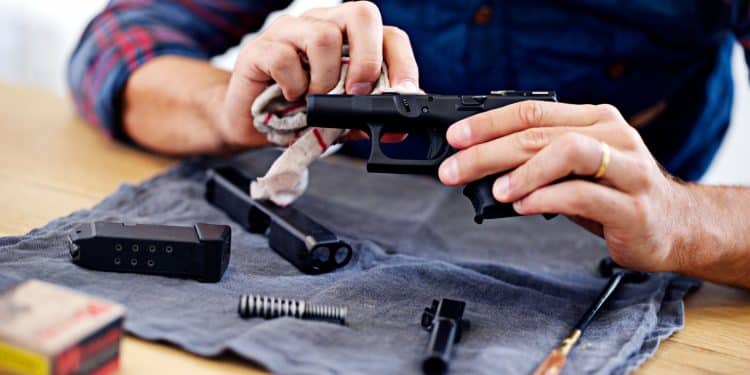Firearm safety is of paramount importance. With the increase in firearm ownership comes the responsibility of ensuring that these weapons are handled, stored, and used safely. Whether you’re an experienced gun owner or a novice just beginning to explore the world of firearms, adhering to essential rules can prevent accidents and injuries.
This article endeavors to shed light on some of the most critical dos and don’ts of firearm safety. Read on to learn more.
The Do’s Of Firearm Safety
As a gun owner, knowing how to properly handle it is crucial to ensuring your safety, that of your family, and the community. Some dos of firearm safety include:
1. Do Properly Store Firearms
When not in use, firearms should be stored in a way that restricts unauthorized access. Typically, there are several storage solutions, such as gun safes and trigger locks, to consider to ensure firearm safety. But among these solutions, wall mounts have become another popular option for many owners due to their aesthetic appeal and secure functionalities.
For example, if you have a collection of rifles, instead of just placing them in a closet, you can securely mount gun on wall with locked cases and position them out of the reach of your young children. As a result, you can restrict unauthorized access or removal, which is a key consideration of firearm safety.
2. Do Keep The Muzzle Pointed In A Safe Direction
Always be mindful of where the gun’s muzzle is pointing. Even if a gun is believed to be unloaded, treating it as if it’s loaded by keeping the muzzle directed away from people or animals is a fundamental safety protocol. For example, whenever you clean your shotgun, you should ensure it’s pointed at the ground or a safe backdrop, even if you’re certain it’s unloaded.
3. Do Use The Right Ammunition
Always ensure that the ammunition used is suitable for the firearm. Using the wrong ammunition can lead to catastrophic failures, causing injury to the shooter or bystanders. For example, loading your .357 Magnum revolver with .38 Special rounds can potentially damage your gun or hurt yourself or the bystanders when it’s fired.
Therefore, make sure to read the caliber designation on the side of the barrel or slide of your gun and check the length of the ammunition. If you’re unsure what ammunition to use, ask a gunsmith or a more experienced shooter.
4. Do Wear Appropriate Safety Gear
When shooting, it’s important to always wear appropriate safety gear to avoid accidents and injuries. Some common types of gear include:
- Eye protection: This can help protect your eyes from debris, powder burns, and other hazards.
- Ear protection: This can help safeguard your hearing from the loud noise of gunfire that can cause hearing damage.
- Gloves: This can help protect your hands from cuts, abrasions, and burns. Heavy-duty work gloves are a good option.
By wearing these pieces of safety gear, you can ensure protection when handling firearms.
5. Do Educate Children And Household Members
Rather than relying on the hidden-out-of-sight approach, it’s wise to educate children and other household members about the potential dangers of guns. This education can foster respect for guns and reduce curiosity-driven mishaps. For example, if your son shows interest in your gun collection, you should take the opportunity to educate them about the dangers and responsibilities of firearms, thus demystifying them and promoting safe practices.
6. Do Attend Firearm Safety Courses
Whether you’re new to guns or even an experienced owner wanting a refresher, attending safety courses is invaluable. Such courses offer hands-on training, practical insights, and the opportunity to learn from experts, including topics pertaining to firearm safety and gun control regulations. By attending these courses, you can strengthen your knowledge about handling your gun safely.
The Don’ts Of Firearm Safety
Now that you understand the dos of firearm safety, it’s time to learn some things you shouldn’t do when handling firearms. These include:
1. Do Not Leave Firearms Loaded When Not in Use
An important rule of thumb is never to leave a gun loaded when it’s not in use. This minimizes the risk of accidental discharges, especially when cleaning or handling the weapon. For example, after returning from the shooting range, you should ensure to unload your pistol and store the ammunition separately, reducing the risk of any accidents at home.
2. Do Not Modify Your Firearm Irresponsibly
While customizing firearms can be appealing, you must be careful not to make modifications that could jeopardize its safe operation. If considering alterations, it’s important to consult with a professional or gunsmith to ensure safety.
3. Do Not Use Alcohol While Handling Firearms
Impairment from alcohol can greatly reduce your ability to safely handle and operate firearms. Always ensure you’re in a clear state of mind when dealing with guns. For example, you should decline to drink if you know you’ll be showing your new rifle to friends later.
4. Do Not Neglect Regular Maintenance
Just like any machine, firearms require regular maintenance to operate safely. This means cleaning and inspecting the gun regularly, ensuring that it’s free from obstructions, and checking that all components are in good working order. For example, every month, you should take out your gun to clean, oil, and inspect it to prevent misfires down the road.
5. Do Not Hesitate To Secure Firearms During Emotional Distress
During times of emotional distress or crisis, securing firearms can prevent impulsive decisions. If someone in the household is going through a tough time, consider temporarily storing them off-site or using gun locks to restrict access.
Final Thoughts
Firearm safety is a topic that requires continual attention and respect. While the allure of guns can be significant for many, they come with an inherent responsibility. Therefore, adhere to these dos and don’ts to ensure that everyone remains safe and enjoys the world of firearms responsibly.





